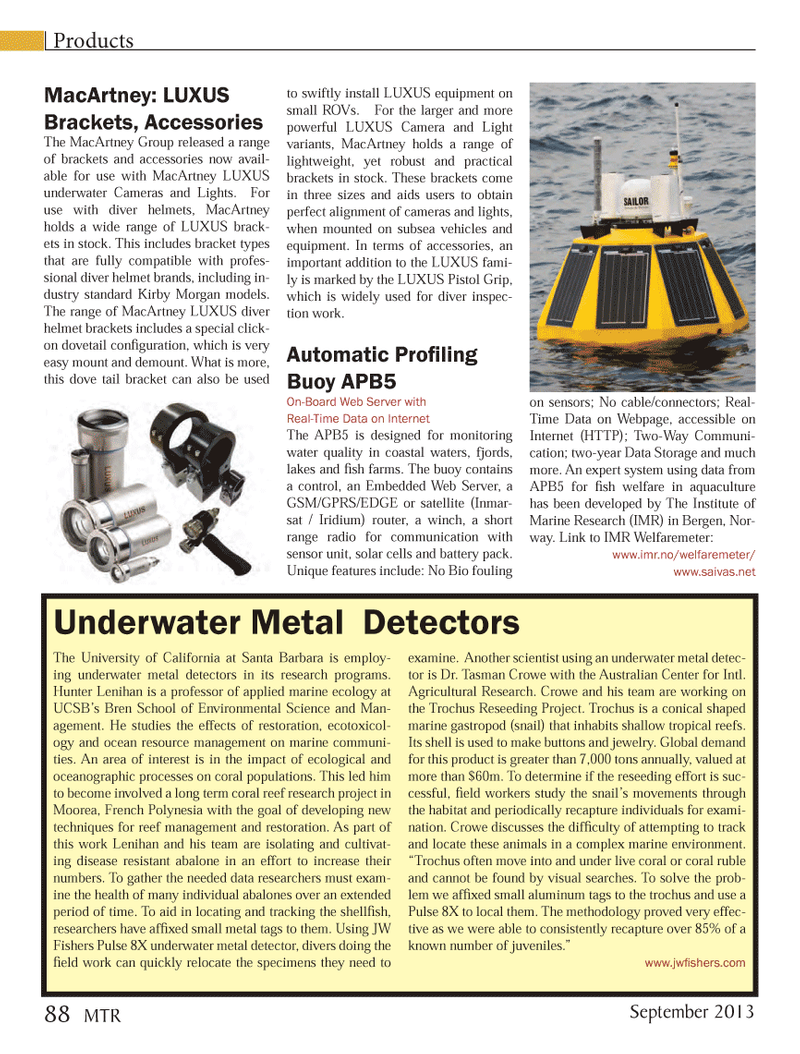
Page 88: of Marine Technology Magazine (September 2013)
Ocean Observation: Gliders, Buoys & Sub-Surface monitoring Networks
Read this page in Pdf, Flash or Html5 edition of September 2013 Marine Technology Magazine
MacArtney: LUXUS Brackets, Accessories The MacArtney Group released a range of brackets and accessories now avail- able for use with MacArtney LUXUS underwater Cameras and Lights. For use with diver helmets, MacArtney holds a wide range of LUXUS brack-ets in stock. This includes bracket types that are fully compatible with profes-sional diver helmet brands, including in- dustry standard Kirby Morgan models. The range of MacArtney LUXUS diver helmet brackets includes a special click- on dovetail conÞ guration, which is very easy mount and demount. What is more, this dove tail bracket can also be used to swiftly install LUXUS equipment on small ROVs. For the larger and more powerful LUXUS Camera and Light variants, MacArtney holds a range of lightweight, yet robust and practical brackets in stock. These brackets come in three sizes and aids users to obtain perfect alignment of cameras and lights, when mounted on subsea vehicles and equipment. In terms of accessories, an important addition to the LUXUS fami- ly is marked by the LUXUS Pistol Grip, which is widely used for diver inspec- tion work. Automatic ProÞ ling Buoy APB5 On-Board Web Server with Real-Time Data on Internet The APB5 is designed for monitoring water quality in coastal waters, fjords, lakes and Þ sh farms. The buoy contains a control, an Embedded Web Server, a GSM/GPRS/EDGE or satellite (Inmar- sat / Iridium) router, a winch, a short range radio for communication with sensor unit, solar cells and battery pack. Unique features include: No Bio fouling on sensors; No cable/connectors; Real-Time Data on Webpage, accessible on Internet (HTTP); Two-Way Communi- cation; two-year Data Storage and much more. An expert system using data from APB5 for Þ sh welfare in aquaculture has been developed by The Institute of Marine Research (IMR) in Bergen, Nor- way. Link to IMR Welfaremeter: www.imr.no/welfaremeter/ www.saivas.net Products The University of California at Santa Barbara is employ- ing underwater metal detectors in its research programs. Hunter Lenihan is a professor of applied marine ecology at UCSBÕs Bren School of Environmental Science and Man- agement. He studies the effects of restoration, ecotoxicol- ogy and ocean resource management on marine communi-ties. An area of interest is in the impact of ecological and oceanographic processes on coral populations. This led him to become involved a long term coral reef research project in Moorea, French Polynesia with the goal of developing new techniques for reef management and restoration. As part of this work Lenihan and his team are isolating and cultivat- ing disease resistant abalone in an effort to increase their numbers. To gather the needed data researchers must exam- ine the health of many individual abalones over an extended period of time. To aid in locating and tracking the shellÞ sh, researchers have afÞ xed small metal tags to them. Using JW Fishers Pulse 8X underwater metal detector, divers doing the Þ eld work can quickly relocate the specimens they need to examine. Another scientist using an underwater metal detec- tor is Dr. Tasman Crowe with the Australian Center for Intl. Agricultural Research. Crowe and his team are working on the Trochus Reseeding Project. Trochus is a conical shaped marine gastropod (snail) that inhabits shallow tropical reefs. Its shell is used to make buttons and jewelry. Global demand for this product is greater than 7,000 tons annually, valued at more than $60m. To determine if the reseeding effort is suc- cessful, Þ eld workers study the snailÕs movements through the habitat and periodically recapture individuals for exami- nation. Crowe discusses the difÞ culty of attempting to track and locate these animals in a complex marine environment. ÒTrochus often move into and under live coral or coral ruble and cannot be found by visual searches. To solve the prob- lem we afÞ xed small aluminum tags to the trochus and use a Pulse 8X to local them. The methodology proved very effec- tive as we were able to consistently recapture over 85% of a known number of juveniles.Ó www.jw Þ shers.com Underwater Metal Detectors September 201388 MTRMTR #7 (82-96).indd 88MTR #7 (82-96).indd 888/23/2013 9:29:30 AM8/23/2013 9:29:30 AM

 87
87

 89
89
